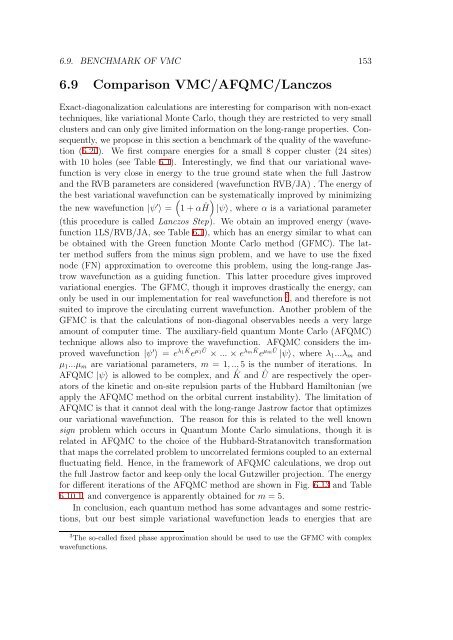pdf, 9 MiB - Infoscience - EPFL
pdf, 9 MiB - Infoscience - EPFL
pdf, 9 MiB - Infoscience - EPFL
Create successful ePaper yourself
Turn your PDF publications into a flip-book with our unique Google optimized e-Paper software.
6.9. BENCHMARK OF VMC 153<br />
6.9 Comparison VMC/AFQMC/Lanczos<br />
Exact-diagonalization calculations are interesting for comparison with non-exact<br />
techniques, like variational Monte Carlo, though they are restricted to very small<br />
clusters and can only give limited information on the long-range properties. Consequently,<br />
we propose in this section a benchmark of the quality of the wavefunction<br />
(6.20). We first compare energies for a small 8 copper cluster (24 sites)<br />
with 10 holes (see Table 6.1). Interestingly, we find that our variational wavefunction<br />
is very close in energy to the true ground state when the full Jastrow<br />
and the RVB parameters are considered (wavefunction RVB/JA) . The energy of<br />
the best variational wavefunction can be systematically improved by minimizing<br />
the new wavefunction |ψ ′ 〉 =<br />
(<br />
1+αĤ<br />
)<br />
|ψ〉, whereα is a variational parameter<br />
(this procedure is called Lanczos Step). We obtain an improved energy (wavefunction<br />
1LS/RVB/JA, see Table 6.1), which has an energy similar to what can<br />
be obtained with the Green function Monte Carlo method (GFMC). The latter<br />
method suffers from the minus sign problem, and we have to use the fixed<br />
node (FN) approximation to overcome this problem, using the long-range Jastrow<br />
wavefunction as a guiding function. This latter procedure gives improved<br />
variational energies. The GFMC, though it improves drastically the energy, can<br />
only be used in our implementation for real wavefunction 3 , and therefore is not<br />
suited to improve the circulating current wavefunction. Another problem of the<br />
GFMC is that the calculations of non-diagonal observables needs a very large<br />
amount of computer time. The auxiliary-field quantum Monte Carlo (AFQMC)<br />
technique allows also to improve the wavefunction. AFQMC considers the improved<br />
wavefunction |ψ ′ 〉 = e λ 1 ˆK e µ 1Û × ... × e λm ˆK e µmÛ |ψ〉, whereλ 1 ...λ m and<br />
µ 1 ...µ m are variational parameters, m =1, .., 5 is the number of iterations. In<br />
AFQMC |ψ〉 is allowed to be complex, and ˆK and Û are respectively the operators<br />
of the kinetic and on-site repulsion parts of the Hubbard Hamiltonian (we<br />
apply the AFQMC method on the orbital current instability). The limitation of<br />
AFQMC is that it cannot deal with the long-range Jastrow factor that optimizes<br />
our variational wavefunction. The reason for this is related to the well known<br />
sign problem which occurs in Quantum Monte Carlo simulations, though it is<br />
related in AFQMC to the choice of the Hubbard-Stratanovitch transformation<br />
that maps the correlated problem to uncorrelated fermions coupled to an external<br />
fluctuating field. Hence, in the framework of AFQMC calculations, we drop out<br />
the full Jastrow factor and keep only the local Gutzwiller projection. The energy<br />
for different iterations of the AFQMC method are shown in Fig. 6.13 and Table<br />
6.10.1, and convergence is apparently obtained for m =5.<br />
In conclusion, each quantum method has some advantages and some restrictions,<br />
but our best simple variational wavefunction leads to energies that are<br />
3 The so-called fixed phase approximation should be used to use the GFMC with complex<br />
wavefunctions.
















